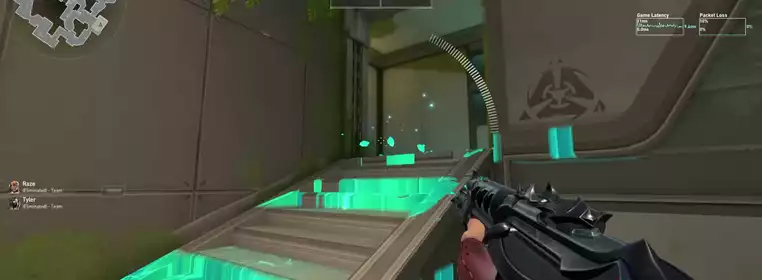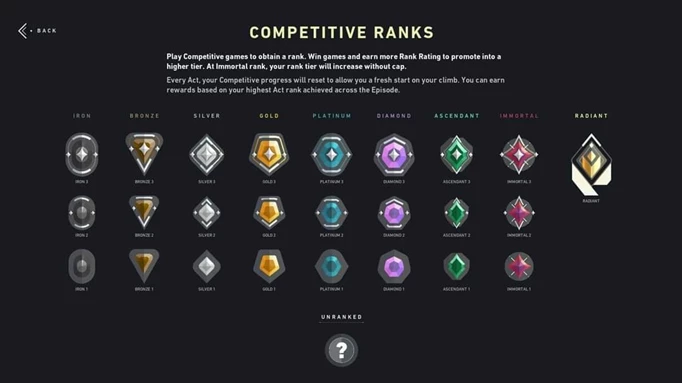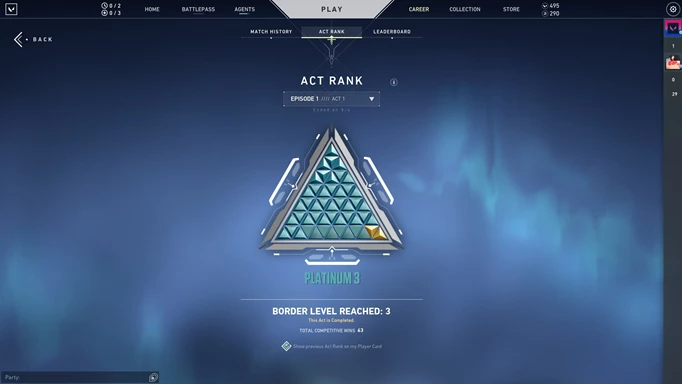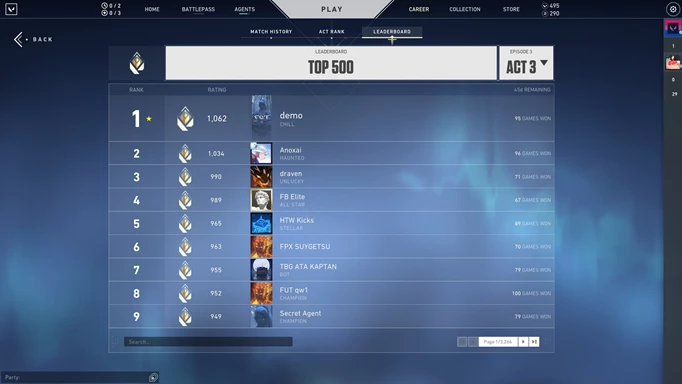VALORANT Ranks and Ranking System Explained

You'll want to know the VALORANT ranks and how ranked works with all the latest updates and changes. Whether you're looking to make it to Immortal and beyond, or you're just wanting to know exactly what it means to be placed in Iron, the VALORANT ranked system is quite confusing. So read on for a full breakdown of the VALORANT ranks in order, and how the ranked system works.
- While you're here, why not check out the latest changes in the VALORANT patch notes 5.12.
All VALORANT Ranks

 Click to enlarge
Click to enlargeIn each "Act" (the name VALORANT has given its seasons) you will be able to compete for different tiers of competition. Acts last roughly two months. Here are the VALORANT ranks in order:
- Iron
- Bronze
- Silver
- Gold
- Platinum
- Diamond
- Ascendant
- Immortal
- Radiant
Here is where it gets complicated. In each Act, only your nine top wins will determine your Act Rank Badge and the border associated with it. That means two things:
- If you win nine games at an Immortal rank and immediately after drop all the way down into Gold, you will still be considered Immortal for the sake of rewards for this Act. That means that playing with friends on your main account becomes a lot less punishing once you’ve hit your goal. Keep in mind that you might still want to maintain your MMR for future seasons, which, as Riot has stated, will transfer.
- You can push your old games from lower rank out by performing better than your top nine games you’ve accrued this Act.
Also, keep in mind that placement games do not count towards your Act Rank. Only once you’ve finished your placements will your wins in that respective Act Rank contribute a rectangle.
The Act Rank Border changes based on the number of games you’ve played in each respective Act. You are able to access your Act Rank history through your profile.
It's also worth noting that the Ascendant rank was only recently added in the episode 5 update in June 2022. Riot added it to change the rank distribution, as many players in Gold and Platinum weren't properly represented.
- Want to know how VALORANT ranks are distributed, check out our VALORANT rank distribution guide.
VALORANT Ranked System Explained

 Click to enlarge
Click to enlargeThe exact algorithm is a mystery, and for good reason. Once a formula is out, it becomes too accurately gameable and changes which would otherwise go unnoticed would cause an uproar when it isn’t necessary. However, we have fairly rigid rules of thumb that have stood the test of time in the gaming sphere, and working from the impressions we’ve received from beta, we can make statements with relative certainty.
VALORANT Ranks: How To Unlock VALORANT Ranked
You will need to play 20 unrated matches in order to unlock VALORANT ranked mode. Note that Spike Rush does not count towards that number.
How Many Placement Matches Do You Need To Play Ranked In VALORANT
You will initially need to play five placement matches in order to get your first rank in VALORANT competitive. After that, each new season will only require three wins to display your new rank.
VALORANT Ranks: What Is MMR in VALORANT?
Matchmaking Rating (MMR) is an invisible number which assesses your level of play behind the scenes. While it will be correlated with your in-game rank, especially in the very beginning, it will either be ahead or behind your real placement, moving you towards the ranking you really deserve. At the start, it’s possible that your MMR very quickly places you as an Immortal, but you’ll need to play a large number of games to arrive at your destination.
While VALORANT doesn’t give you numerical indicators of how much you gained, it does give you arrows to look at to see just how much your rank has changed based on your performance in the match. It’s worth keeping an eye on this indicator.
Upon release of the game, Riot stated that all beta progress has been reset, suggesting that MMR was part of that. Anecdotally, by the strength of the opponents we faced, this seems to be true.
MMR matters as it’s the actual evaluation of your skill and will determine the trajectory you are on in the pursuit of higher rankings. It decides who you get teamed up with and who you play against. You will have noticed that you had lower-ranking players on your team that still could hang with the rest. That is because their rank has not caught up to their MMR that is likely roughly equal to yours.
It is likely that Riot Games will use MMR information gathered from your normal history and will use it to initially place you at an approximate skill level that you have shown in your normal matches.

 Click to enlarge
Click to enlarge

 Click to enlarge
Click to enlargeWhat Contributes Towards Your VALORANT Rank?
You’ve likely had experiences in other games in which you finished your placement matches with an equal score to your friend, yet they ranked higher than you. Given what we know about the ranking system in VALORANT, this could be based on two factors: Either your individual MMR was lower than your friends based on how they performed in their normal matches or they had better individual performances in their ranked matches.
Another crucial aspect to understand, in order to get the most out of your rating, is that VALORANT uses a ranking system that relies on more than just a win/loss ratio to evaluate your play. Additionally, your individual performance is taken into account. While no specifics are known, it is likely to at least be loosely correlated with your Match Score which is made up of a formula rating your performance based on (First) Kills, (First) Death, Econ Rating and so on.
Your first goal should always be to win matches no matter what as you’re unlikely to ever meaningfully outperform the rating that you will lose from a loss by the rating you will gain based on your individual performance. Therefore, the player that gains the most rating consistently is the one that makes plays which allow them to win the most matches.
Playing aggressively might boost your individual performance score by getting more kills, but you have to have the skills to back it up when flying around the corner. Calm and calculated play will less often throw rounds away, leading to a consistent rating gain in the process. If you are a player that gets a lot of value out of playing aggressively, it is, of course, advised to do so.
- Sick of being on the losing side? Here's how to surrender in VALORANT.
How Are Teammates Chosen In VALORANT Ranked?
Each team will have an aggregate MMR rating which will determine team strength (potentially with some unknown modifiers). The matchmaker will try to put you against opponents of equal skill level but will sometimes fail to do so. In these cases, you will gain more MMR and rank from winning if you’re the underrated team while you will lose less in the case of defeat.
Another factor in aggregating these MMR ratings per team is the group size that everyone is queueing with. While again, specifics are unknown, it is likely that Riot will first try to find a stack of a similar size and strength and put you in a match against them. If this fails within a reasonable time frame, you will be matched against solo queue players who are likely ranked higher than you are but lack the bonus of team play to even out the match.
How Does Queueing With A Team Affect VALORANT Ranked?
Because of the aforementioned information, it is paramount that you and your friends do your best to work together as a team. The system likely has an inherent weight attached to stacks and it expects you to perform better than a group of random players of equal skill thrown together. If you don’t exceed the effectiveness of that value, you will have a hard time climbing in with a group of friends at some point.
The beauty (and for some the beast) of this system is that you can absolutely outperform your individual skill rating by being more effective as a team than the matchmaker expects you to. If you see top players bemoaning the fact that flexible queues from 1-5 players exist, it’s because these pros have internalized the importance of team play and will reliably outperform expectations based on their team play.
In a game like VALORANT, playing together is of the utmost importance and the higher you get, the less your individual skill will matter, especially as long as Riot Games decides to run with these flexible queues.
Therefore, the best way to climb is a group of friends that are eager to play with each other as a team who also aren’t of wildly different skill levels.
Now you know everything there is to know about VALORANT ranked, why not check out the best VALORANT crosshair settings?
